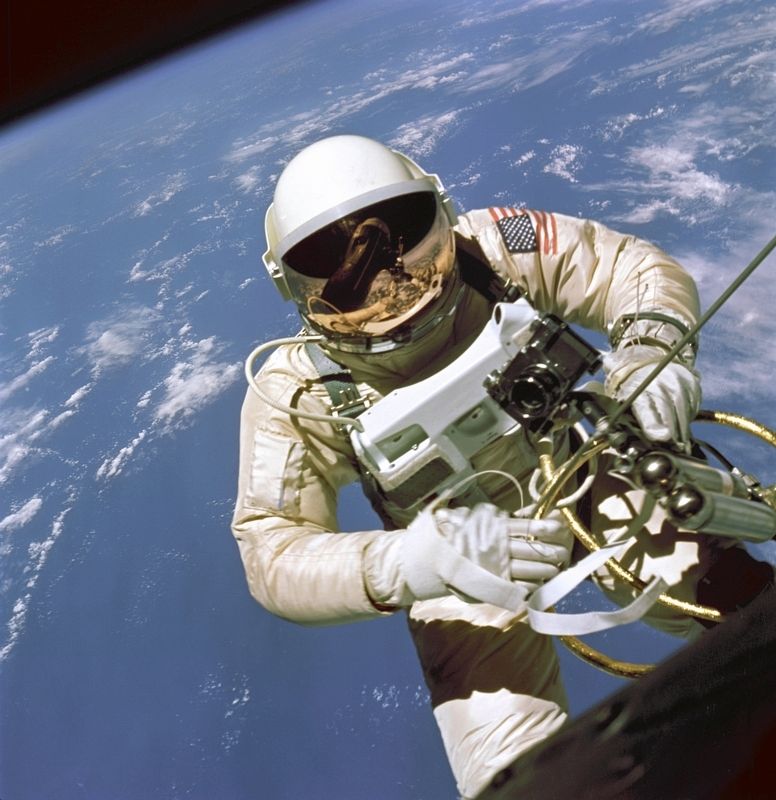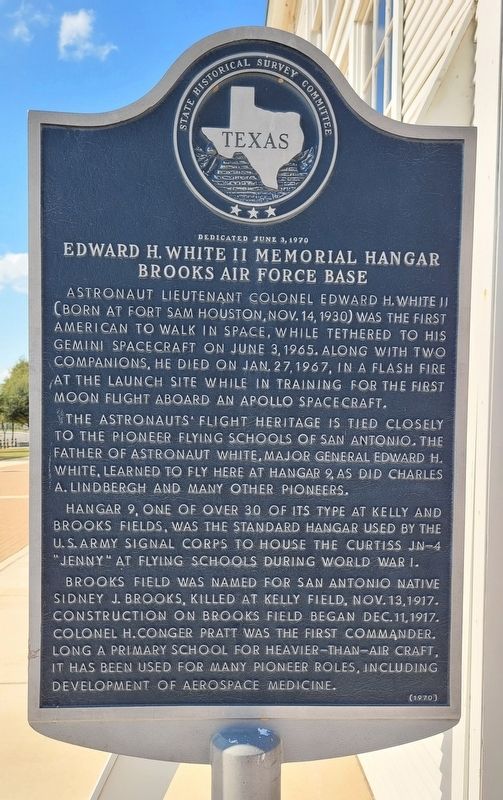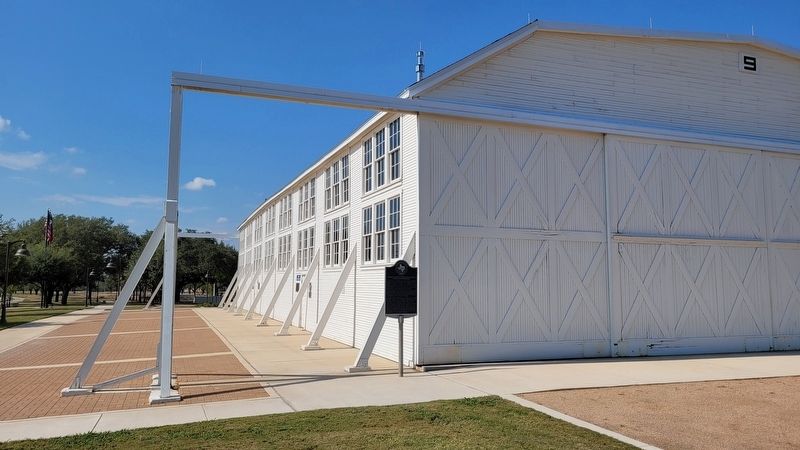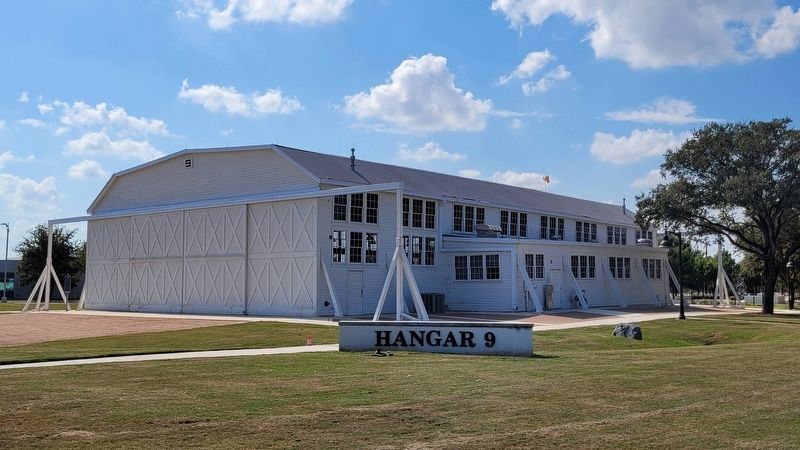Southside in San Antonio in Bexar County, Texas — The American South (West South Central)
Edward H. White II Memorial Hangar, Brooks Air Force Base
Dedicated June 3, 1970
Inscription.
Astronaut Lieutenant Colonel Edward H. White II (born at Fort Sam Houston, Nov. 14, 1930) was the first American to walk in space, while tethered to his Gemini spacecraft on June 3, 1965. Along with two companions, he died on Jan. 27, 1967, in a flash fire at the launch site while in training for the first moon flight aboard an Apollo spacecraft.
The astronauts flight heritage is tied closely to the pioneer flying schools of San Antonio. The father of astronaut White, Major General Edward H. White, learned to fly here at Hangar 9, as did Charles A. Lindbergh and many other pioneers.
Hangar 9, one of over 30 of its type at Kelly and Brooks Fields, was the standard hangar used by the U.S. Army Signal Corps to house the Curtiss JN-4 "Jenny" at flying schools during World War I.
Brooks Field was named for San Antonio native Sidney J. Brooks, killed at Kelly Field, Nov. 13,1917. Construction on Brooks Field began Dec. 11, 1917. Colonel H. Conger Pratt was the first commander. Long a primary school for heavier-than-air craft, it has been used for many pioneer roles, including development of aerospace medicine.
Erected 1970 by State Historical Survey Committee. (Marker Number 1398.)
Topics. This historical marker is listed in these topic lists: Air & Space • War, World I. A significant historical date for this entry is June 3, 1965.
Location. 29° 20.645′ N, 98° 26.636′ W. Marker is in San Antonio, Texas, in Bexar County. It is in Southside. Marker is at the intersection of South New Braunfels Avenue and Inner Circle Drive, on the right when traveling south on South New Braunfels Avenue. The marker is located on the eastern corner of the hanger building. Touch for map. Marker is in this post office area: San Antonio TX 78235, United States of America. Touch for directions.
Other nearby markers. At least 8 other markers are within walking distance of this marker. Brooks Air Force Base Hangar 9 (a few steps from this marker); Brooks Field Hangar 9 (a few steps from this marker); In Memory of their Fallen Classmates (within shouting distance of this marker); Brooks Is Born (within shouting distance of this marker); Space Mission (within shouting distance of this marker); Hangar 9 Prevails (within shouting distance of this marker); An Epic Visit (within shouting distance of this marker); Aerial Revolutions (within shouting distance of this marker). Touch for a list and map of all markers in San Antonio.
Also see . . . Ed White (astronaut). Wikipedia
White was selected as one of the second group of astronauts, the so-called "Next Nine", who were chosen to take part in the Gemini and Apollo missions. He was assigned as pilot of Gemini 4 alongside command pilot James McDivitt. On June 3, 1965, White became the first American to walk in space. He was then assigned as senior pilot of the first crewed Apollo mission, Apollo 1. White died on January 27, 1967, alongside astronauts Virgil "Gus" Grissom and Roger B. Chaffee in a fire during pre-launch testing for Apollo 1 at Cape Canaveral, Florida. He was awarded the NASA Distinguished Service Medal for his flight in Gemini 4 and was then awarded the Congressional Space Medal of Honor posthumously.(Submitted on October 16, 2022, by James Hulse of Medina, Texas.)

Public Domain - NASA Photo, June 3, 1965
4. Astronaut Edward H. White II
On June 3, 1965 Edward H. White II became the first American to step outside his spacecraft and let go, effectively setting himself adrift in the zero gravity of space. For 23 minutes White floated and maneuvered himself around the Gemini spacecraft while logging 6500 miles during his orbital stroll. White was attached to the spacecraft by a 25 foot umbilical line and a 23-ft. tether line, both wrapped in gold tape to form one cord. In his right hand White carries a Hand Held Self Maneuvering Unit (HHSMU) which is used to move about the weightless environment of space. The visor of his helmet is gold plated to protect him from the unfiltered rays of the sun.
Credits. This page was last revised on February 2, 2023. It was originally submitted on October 16, 2022, by James Hulse of Medina, Texas. This page has been viewed 131 times since then and 46 times this year. Photos: 1, 2, 3, 4. submitted on October 16, 2022, by James Hulse of Medina, Texas.


